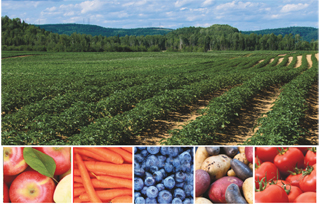The St. Lawrence River Valley is the heart of the province’s agricultural sector. The region’s rich, arable soils and a relatively warm climate is well suited to apple growing. The Centre-du-Quebec region, located midway between Montreal and Quebec City on the south shore of the St. Lawrence, grows an abundance of cranberries, strawberries, and raspberries, while blueberries abound in the Saguenay Lac-St. Jean region, named for the Saguenay River and the immense Lake St.-Jean. The Côte-Nord region, located in the northeastern portion of the province, is also a significant blueberry producing region.
Centre Maraîcher Eugène Guinois, Jr. Inc., a grower and exporter, specializes in various types of lettuce, as well as broccoli, cabbage, onions, carrots, and celery.
Located near the New York state border in St. Clotilde de Chateauguay, Arthur Patenaude, in sales, comments, “Thinking back to the summer of 2014, we had our challenges. Like everywhere else, weather is a factor that drives our industry.” The company’s high-tech 25,000-square-foot warehouse helps in that regard, so vegetables can be transferred quickly from the fields and vacuum-cooled at the facility. “Our harvesting crew and sales team work to get the most out of our crop,” he confirms. Better yet, he adds, “Pricing was very good.”
Among market trends, Patenaude finds consumers “are always looking for packaged or ready-to-use product,” which is why Centre Maraîcher has partnered with a cutting-edge packaging firm for its value-added items.
According to Statistics Canada, Quebec experienced a significant drop in fruit sales in 2013 but saw an increase in vegetable sales, such as leafy greens and potatoes. Quebec’s Ministry of Agriculture reports the total value of field and greenhouse vegetables grown in 2013 was $417.1 million, including $131.7 million of potatoes.
Prince Edward Island
Although Prince Edward Island (PEI) is the smallest province, it’s also Canada’s top potato producer, accounting for a quarter of the country’s potatoes. The potato industry is worth more than $1 billion to PEI’s economy each year.
Approximately 60 percent of PEI or “Spud Island” potatoes are destined for processing into French fries and potato chips, 30 percent go to the fresh market through retail or foodservice, and the remaining 10 percent are grown for seed purposes.
In 2013, PEI producers harvested potatoes totaling 25 million hundredweight of product. The province’s potato farm cash receipts vary from $200 to $260 million annually, and approximately 90,500 acres of PEI potatoes were planted in 2014. PEI’s seed and table potatoes are shipped to over 20 countries annually, including the United States. In 2013, PEI’s fresh potato exports were valued at $45.5 million and frozen potato exports reached $194.7 million.



